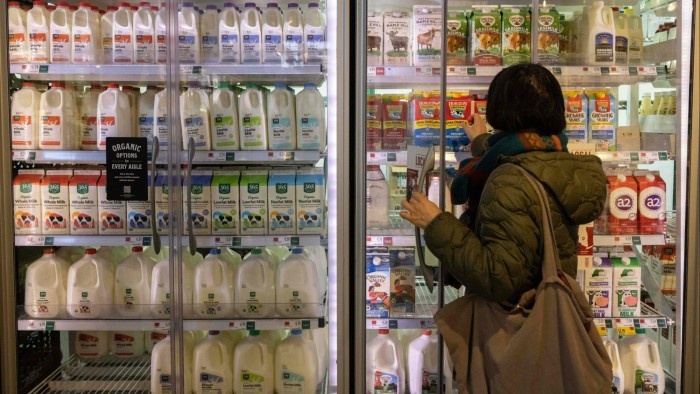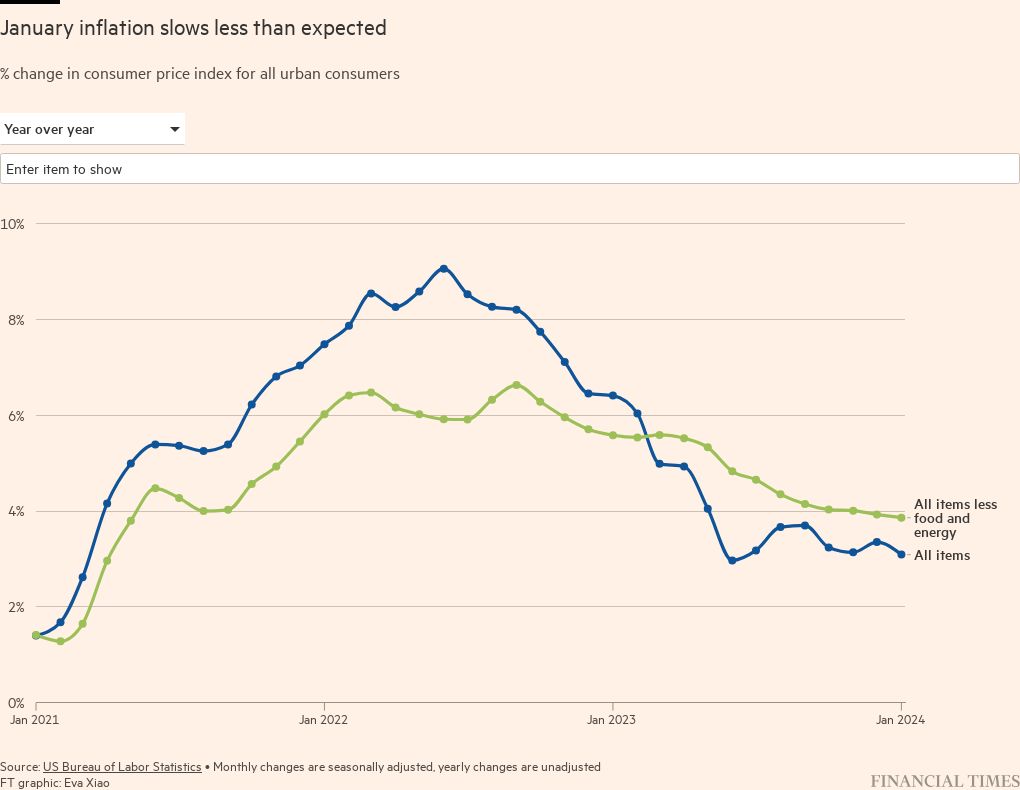US stocks drop and Treasury yields jump as inflation data shakes rate bets

Simply sign up to the US inflation myFT Digest -- delivered directly to your inbox.
US stocks dropped and Treasury yields jumped on data that showed US inflation easing less than expected, as investors scaled back bets that the Federal Reserve will begin cutting interest rates as soon as May.
The S&P 500 index of blue-chip US stocks closed down 1.4 per cent on Tuesday. The tech-heavy Nasdaq Composite dropped by 1.8 per cent.
The market moves came after new government figures showed US inflation cooled less than expected in January, to 3.1 per cent year on year.
Following Tuesday’s release, the likelihood of a rate cut in May implied by futures markets fell from 50 per cent to 30 per cent, while the chances of a cut in March were almost fully eliminated.
The two-year Treasury yield, which moves with interest rate expectations, rose 0.18 percentage points to 4.65 per cent, its biggest one-day move since last March. The benchmark 10-year yield increased 0.14 percentage points to 4.31 per cent. Yields rise as prices fall.
The figures come as the Fed considers when to start trimming interest rates from their current level of 5.25 per cent to 5.5 per cent after a lengthy campaign to tame persistent price pressures.
“This is inconvenient data for the Fed and [any] plan to cut rates relatively soon,” said Dean Maki, chief economist at Point72 Asset Management. “I think this takes a March rate cut off the table, and it makes a May cut unlikely.”
Economists polled by Bloomberg had forecast annual consumer price inflation of 2.9 per cent, down from 3.4 per cent in December.
Core inflation, a closely watched measure that strips out volatile food and energy prices, was 3.9 per cent year on year in January, in line with the previous month.
The dramatic overall fall in inflation over the past year has prompted central bankers in the US, Europe and UK to rule out further rate increases and start discussing the possibility of cuts.
Fed chair Jay Powell said last month the Federal Open Market Committee expected to cut interest rates three times this year, but he signalled it was unlikely to begin doing so until more progress had been made towards the central bank’s 2 per cent inflation target.
“The Fed will likely need more data to feel comfortable [before cutting rates],” said Kristina Hooper, chief global market strategist at Invesco. “Progress is still happening, but is probably not happening as quickly as the Fed would like.”
US President Joe Biden said on Tuesday: “At a time when growth and employment remain strong, inflation declined by two-thirds from its peak but we know there’s still work to do to lower costs.”
The dollar, whose movements are influenced by changes in rate expectations, traded 0.6 per cent higher on the inflation data release.
Housing, vehicle insurance and medical care all contributed to January’s price pressures. Shelter, the largest component of which is rental costs, was the biggest influence on core inflation, with the index increasing 0.6 per cent in January.
Tuesday’s figures showed that while the ongoing trend of deflation in core goods continued, inflation in services remained strong, in part due to an increase in medical care costs.
The Fed’s preferred measure of inflation is the core personal consumption expenditures index, which has slowed more drastically than CPI. The core PCE index was up 2.9 per cent in January on an annual basis, the first reading of less than 3 per cent in about three years.
The Fed’s next policy meeting is scheduled for March 19-20, at which it will release its latest “dot plot” survey showing officials’ projections for interest rates, inflation and unemployment.

Comments